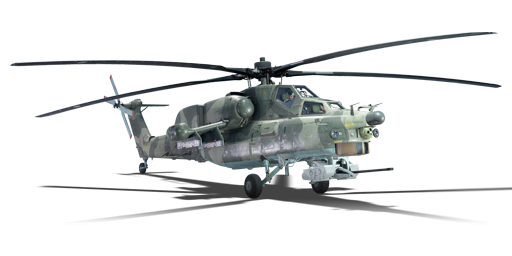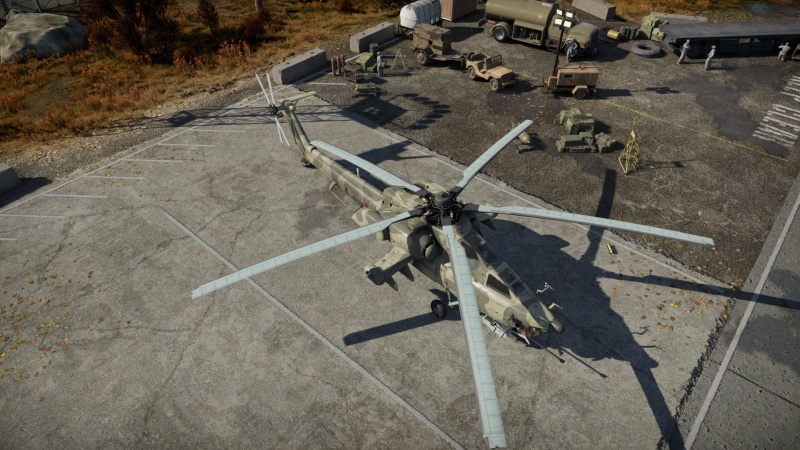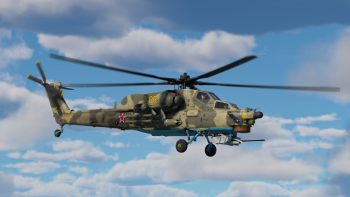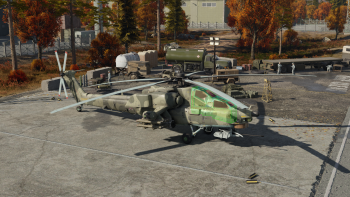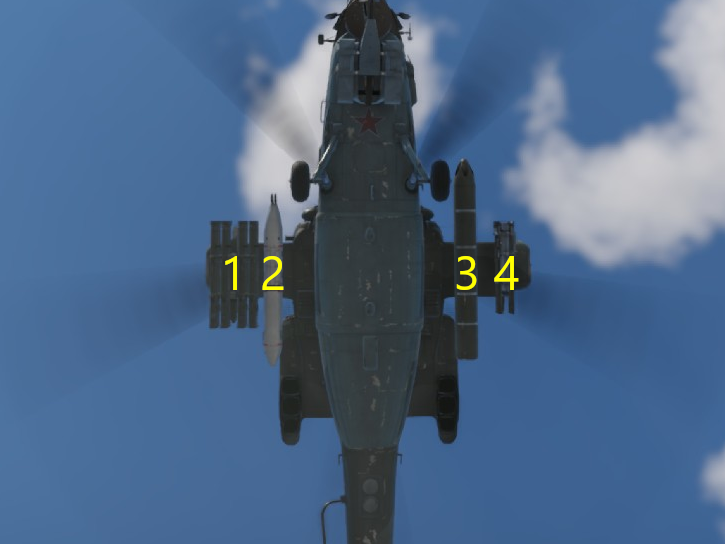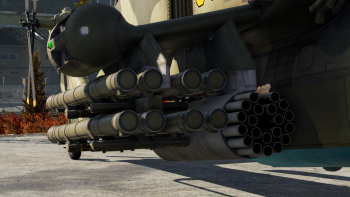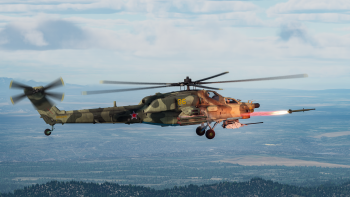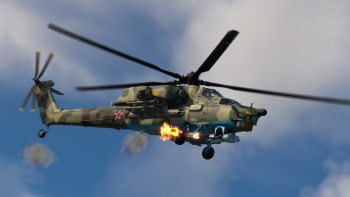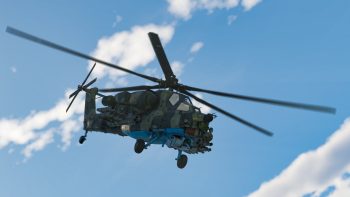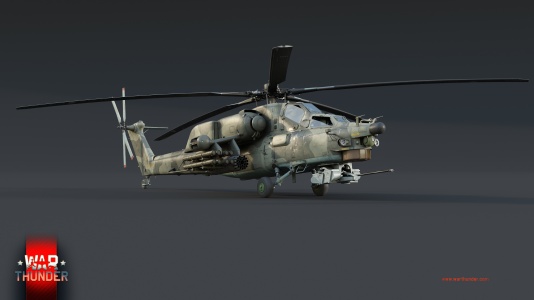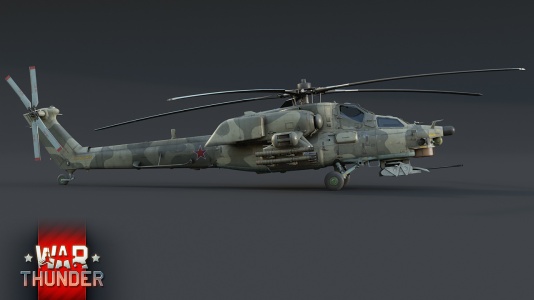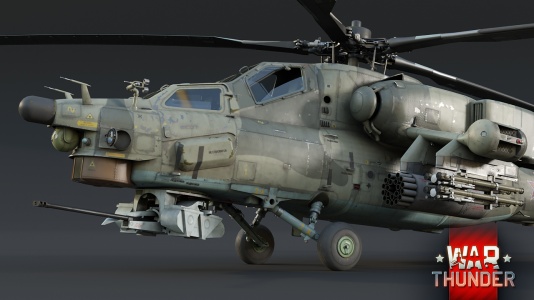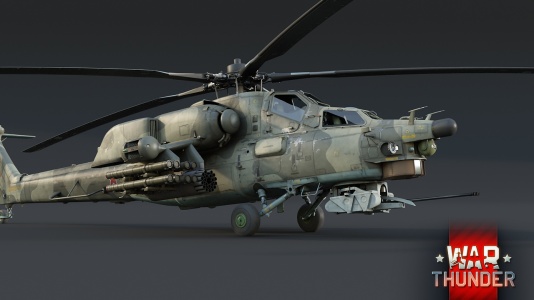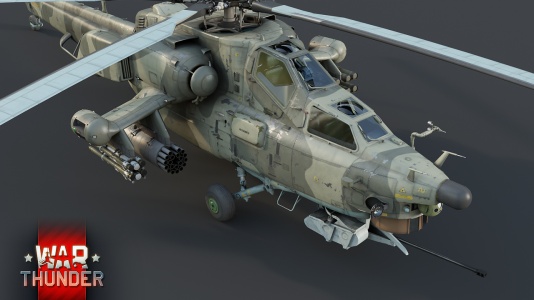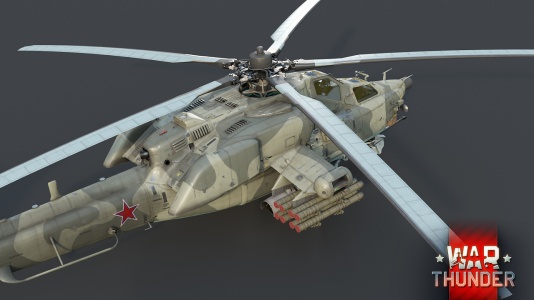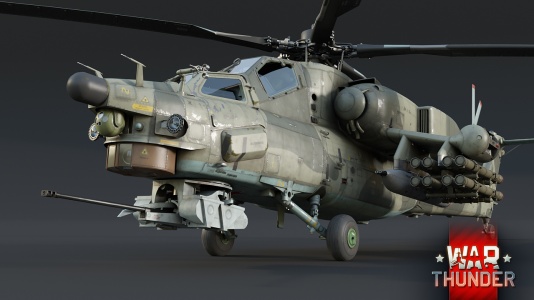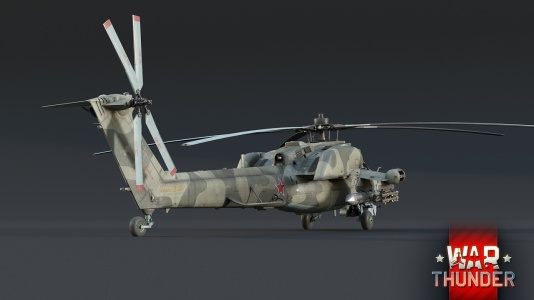Difference between revisions of "Mi-28N"
m (Edits.) |
(→Armaments: Reformatted) |
||
| (30 intermediate revisions by 13 users not shown) | |||
| Line 1: | Line 1: | ||
| − | {{Specs-Card|code=mi_28n}} | + | {{About |
| + | | about = Soviet attack helicopter '''{{PAGENAME}}''' | ||
| + | | usage = other versions | ||
| + | | link = Mi-28 (Family) | ||
| + | }} | ||
| + | {{Specs-Card | ||
| + | |code=mi_28n | ||
| + | |images={{Specs-Card-Image|GarageImage_{{PAGENAME}}.jpg}} | ||
| + | }} | ||
== Description == | == Description == | ||
<!-- ''In the description, the first part should be about the history of and the creation and combat usage of the helicopter, as well as its key features. In the second part, tell the reader about the helicopter in the game. Insert a screenshot of the vehicle, so that if the novice player does not remember the vehicle by name, he will immediately understand what kind of vehicle the article is talking about.'' --> | <!-- ''In the description, the first part should be about the history of and the creation and combat usage of the helicopter, as well as its key features. In the second part, tell the reader about the helicopter in the game. Insert a screenshot of the vehicle, so that if the novice player does not remember the vehicle by name, he will immediately understand what kind of vehicle the article is talking about.'' --> | ||
| − | + | The '''{{Specs|name}}''' (NATO Code: Havoc) is a Russian attack helicopter designed with the intent of overcoming the limitations found in its predecessor, the Mi-24. It was developed in the 2000s and entered service with the Russian military in 2009. While the Hind can be considered a "flying IFV" combining armament and troop transport capability, the Havoc mostly abandons the latter in order to become a dedicated attack helicopter. It maintains the Mil Mi tradition of heavy weight, strong armour protection (by helicopter standards), and inelegant looks, but without the volume required to ferry troops, the airframe does not feel as bulky in flight. | |
| − | + | ||
| − | The '''{{Specs|name}}''' is a | + | The {{Specs|name}} was introduced in [[Update 1.93 "Shark Attack"]]. Its suspended ordnance is almost the same as the preceding [[Mi-35M]], relying mostly on Ataka ATGMs and unguided rockets for tank busting and Igla MANPADS for air defence, but it is capable of carrying two times as many ATGMs. The cherry on the top is the massive chin turret carrying a 30 mm 2A42 autocannon, the same model used by the [[BMP-2]], with wide firing angles, APDS rounds, and an auto-tracker. Although sniping tanks with ATGMs is much safer in the face of enemy SAMs, pilots brave enough to bring the {{Specs|name}} into close combat can indeed wreak havoc on unsuspecting opponents. |
== General info == | == General info == | ||
=== Flight performance === | === Flight performance === | ||
| − | ''Describe how the helicopter behaves in the air. Speed, manoeuvrability, acceleration and allowable loads - these are the most important characteristics of the vehicle.'' | + | {{Specs-Heli-Flight}} |
| + | <!-- ''Describe how the helicopter behaves in the air. Speed, manoeuvrability, acceleration and allowable loads - these are the most important characteristics of the vehicle.'' --> | ||
| + | [[File:Mi-28N in flight.png|thumb|350px|Mi-28N in flight]] | ||
| + | {| class="wikitable" style="text-align:center" | ||
| + | |- | ||
| + | ! rowspan="2" | Characteristics | ||
| + | ! colspan="2" | Max Speed<br>(km/h at 1,000 m) | ||
| + | ! rowspan="2" | Max altitude<br>(metres) | ||
| + | |- | ||
| + | ! AB !! RB | ||
| + | |- | ||
| + | ! Stock | ||
| + | | 273 || 256 || rowspan="2" | {{Specs|ceiling}} | ||
| + | |- | ||
| + | ! Upgraded | ||
| + | | 324 || 300 | ||
| + | |- | ||
| + | |} | ||
| + | |||
| + | === Survivability and armour === | ||
| + | {{Specs-Heli-Armour}} | ||
| + | <!-- ''Examine the survivability of the helicopter. Note how vulnerable the structure is and how secure the pilot is, whether the fuel tanks are armoured, etc. Describe the armour, if there is any, and also mention the vulnerability of other critical systems.'' --> | ||
| + | [[File:Mi-28N cockpit armour.png|thumb|350px|Armour on the Mi-28N]] | ||
| + | ;Armour plates | ||
| + | |||
| + | * 42 mm Bulletproof glass (52°) - Frontal windshield | ||
| + | * 22 mm Bulletproof glass - Side windows | ||
| + | * 10 mm Aluminium alloy - Cockpit front, middle, rear and bottom | ||
| + | * 10 mm Aluminium alloy - Cockpit sides and doors | ||
| + | * 16 mm Ceramic - Cockpit sides | ||
| + | * 8 mm Steel - Canopy framing | ||
| + | |||
| + | The gunner and the pilot are protected frontally and laterally by bulletproof glass. The front, rear, lower side and bottom of the cockpit are protected by aluminium alloy plates and there is an additional protection plate between the pilot and the gunner. The lower sides of the cockpit are protected by aluminium alloy superposed to ceramic while the canopy cockpit is protected by steel and bulletproof glass. The fuel tanks are also located at the bottom of the craft behind the crew. Both crewmembers can control the machine. | ||
| + | |||
| + | The helicopter uses an SPO-15 Radar Warning Receiver. This RWR can pick up radar frequencies from the G-I band, which means that it will not detect many of the search radars equipped on SPAA that it faces. Additionally, even on the systems that it is able to detect, IRST tracking is commonly used which is also undetectable, thus attention still needs to be paid to watch for potential missile launches. Most aircraft radars search and track on I band, so the Mi-28N will not be entirely oblivious to close air patrol fighters that have their radar turned on. | ||
| + | |||
| + | The Mi-28N can be equipped with 128 countermeasures. Flares launch to the sides from the wingtips. When flaring ground-based IR SAMs, dodge by pointing the sides at the missile. Pre-flaring generally is an option if the situation calls for it, but using the environment and staying aware is key. The helicopter is quite a bit more manoeuvrable than the Mi-24 series. | ||
| + | |||
| + | === Modifications and economy === | ||
| + | {{Specs-Economy}} | ||
| + | |||
| + | == Armaments == | ||
| + | {{Specs-Heli-Armaments}} | ||
{| class="wikitable" style="text-align:center" | {| class="wikitable" style="text-align:center" | ||
|- | |- | ||
| − | ! colspan="3" | | + | ! colspan="3" | [[Ballistic Computer]] |
|- | |- | ||
| − | ! | + | ! CCIP (Guns) !! CCIP (Rockets) !! CCIP (Bombs) |
|- | |- | ||
| − | + | | {{Tick}} || {{Tick}} || {{Cross}} | |
| − | ! | + | |- |
| + | |} | ||
| + | === Offensive armament === | ||
| + | {{Specs-Heli-Offensive}} | ||
| + | <!-- ''Describe the offensive armament of the helicopter, if any. Describe how effective the cannons and machine guns are in battle, also what ammunition belts or drums are better to use. If there is no offensive weaponry, delete this subsection.'' --> | ||
| + | {{main|2A42 (30 mm)}} | ||
| + | |||
| + | The '''''{{PAGENAME}}''''' is armed with: | ||
| + | |||
| + | * 1 x 30 mm 2A42 cannon, chin turret (250 rpg) | ||
| + | * 128 x countermeasures | ||
| + | |||
| + | The 30 mm 2A42 is the strongest helicopter cannon in War Thunder, with a high rate of fire and punchy APDS rounds that can rip through roof armour and turn light vehicles into Swiss cheese. Although it can be seen on Kamov helicopters such as the [[Ka-29|Ka-29 Helix]] and [[Ka-50|Ka-50 Hokum]], their cannons are mounted on the fuselage sides with limited articulation, forcing the pilot to point the helicopter's nose close to the target. The Mi-28N's chin turret holds less ammunition but has much better articulation, so once a target is acquired by the auto tracker, the pilot hold down the trigger and otherwise continue flying normally. | ||
| + | |||
| + | The Mi-28N noticeably lacks the HIRSS and IRCM systems of the previous Mi-35M, which reduces its protection against IR missiles somewhat, but at its battle rating there are typically much greater threats to look out for. | ||
| + | |||
| + | === Suspended armament === | ||
| + | {{Specs-Heli-Suspended}} | ||
| + | <!-- ''Describe the helicopter's suspended armament: additional cannons under the winglets, any bombs, and rockets. Since any helicopter is essentially only a platform for suspended weaponry, this section is significant and deserves your special attention. If there is no suspended weaponry remove this subsection.'' --> | ||
| + | |||
| + | The '''''{{PAGENAME}}''''' can be outfitted with the following ordnance: | ||
| + | |||
| + | {| class="wikitable" style="text-align:center" width="100%" | ||
|- | |- | ||
| − | ! | + | ! !! width="11%" | 1 !! width="11%" | 2 !! width="11%" | 3 !! width="11%" | 4 |
| + | | rowspan="6" width="30%" | <div class="ttx-image">[[File:Hardpoints_{{PAGENAME}}.png]]</div> | ||
|- | |- | ||
| − | | | + | ! [[GSh-23L (23 mm)|23 mm GSh-23L]] cannons (250 rpg) |
| + | | || 1 || 1 || | ||
|- | |- | ||
| − | ! | + | ! [[S-8KO]] rockets |
| + | | 20 || 20 || 20 || 20 | ||
|- | |- | ||
| − | ! | + | ! [[S-13OF]] rockets |
| − | + | | 5 || 5 || 5 || 5 | |
|- | |- | ||
| − | ! | + | ! [[9M39 Igla]] missiles |
| + | | 4 || || || 4 | ||
|- | |- | ||
| − | | | + | ! [[9M120 Ataka]] missiles |
| + | | 4, 8 || || || 4, 8 | ||
|- | |- | ||
|} | |} | ||
| − | = | + | {{Navigation-Start|Default weapon presets}} |
| − | + | {{Navigation-First-Simple-Line}} | |
| + | * Without load | ||
| + | * 8 x 9M39 Igla missiles | ||
| + | * 80 x S-8KO rockets | ||
| + | * 20 x S-13OF rockets | ||
| + | * 4 x 9M120 Ataka missiles | ||
| + | * 8 x 9M120 Ataka missiles | ||
| + | * 16 x 9M120 Ataka missiles | ||
| + | * 2 x 23 mm GSh-23L cannons (250 rpg = 500 total) | ||
| + | {{Navigation-End}} | ||
| − | + | The Mi-28N's weapons and even hardpoints will feel very familiar to players who have spaded the [[Mi-35M]]. The only differences are that the obsolete 9M114 Shturm is completely dropped from the arsenal and that both outboard hardpoints can support Ataka racks, not just the right side. | |
| − | + | [[File:Mi-28N suspended armament.png|thumb|350px|Mi-28N armed with Ataka ATGMs and S-8KO unguided rockets]] | |
| − | ' | ||
| − | + | Although the Mi-28N's ability to carry two racks of Atakas is a great boon for tank hunting, this introduces a new conundrum: Atakas and Iglas now compete for hardpoint space. Although it is nice to have some all-aspect MANPADS for warding off enemy aircraft, cutting the ATGM capacity in half is a considerable tradeoff for a missile with poor overload and a small warhead. If there are teammates with contemporary SAM systems like the [[2S6|2S6 Tunguska]], it is usually better to go all-in on Atakas. The Atakas themselves are actually quite effective in helicopter jousts due to their high flight speed and the chin-mounted 2A42 will happily shred planes, so a Havoc without Iglas is not exactly helpless against enemy aircraft either. | |
| − | |||
| − | + | The inner two hardpoints should be used to carry unguided rockets, and again there is a choice between S-8KO HEAT rockets and S-13OF HE rockets. At the Havoc's battle rating, most MBTs have good composite armour that can stop the HEAT warheads from the front, so the HE rockets tend to be more practical: they will easily obliterate light targets even with near misses, and it is often more reliable to score an overpressure kill on an MBT, especially with side attacks, than it is to fire a huge rocket swarm and hope that some of them get lucky. Pilots can also choose to forego these to save on weight. | |
| − | ' | ||
== Usage in battles == | == Usage in battles == | ||
| − | ''Describe the tactics of playing in a helicopter, the features of using the helicopter in a team and advice on tactics. Refrain from creating a "guide" - do not impose a single point of view, but instead, give the reader food for thought. Examine the most dangerous enemies and give recommendations on fighting them. If necessary, note the specifics of the game in different modes (AB, RB, SB).'' | + | <!-- ''Describe the tactics of playing in a helicopter, the features of using the helicopter in a team and advice on tactics. Refrain from creating a "guide" - do not impose a single point of view, but instead, give the reader food for thought. Examine the most dangerous enemies and give recommendations on fighting them. If necessary, note the specifics of the game in different modes (AB, RB, SB).'' --> |
| + | '''Ground RB''' | ||
| + | |||
| + | The Mi-28N is a fast, heavily armed and armoured, but not very manoeuvrable helicopter. For many, the Havoc is the perfect helicopter for utter destruction, given it can mount a total of sixteen Ataka ATGMs as well as HE rockets as just some icing on the cake. Combined with the 2A42 autocannon equipped with APDS rounds penetrating 82 mm of armour, high-resolution thermals and decent survivability, the Havoc is great for all missions. It's a great first-spawner; 8 Igla AAMs are very useful, especially at the start of matches. They've got great flare resistance, and while they may not pull as much as a Mistral or TY-90, they can still be great for shooting down dangerous enemies like A-10s and other jets that have just spawned in the air. | ||
| + | |||
| + | '''With ATGMs''' | ||
| + | [[File:Mi-28N firing a missile.png|thumb|350px|Mi-28N firing an Ataka ATGM]] | ||
| + | At a comfortable range, 16 Atakas is more than enough ATGMs to deal with any and all threats that your team faces. It's suggested to go for priority targets first, the targets that your team is struggling to eliminate, like an enemy tank in a hull-down position, or for you, any SPAAs that may be in the area. This will be very useful for your team. If you run out of Atakas, it is advised to return to base and rearm for a second run. | ||
| + | |||
| + | It's advised to watch for SPAAs first before you get down to business. At this battle rating, SAMs are incredibly deadly. Once one fires on you, you've run out of options if you're unable to terrain mask. Their missiles can reach you in seconds from kilometres away, so always be sure you are clear of enemy air defence before engaging the rest of the enemy team. If at low altitude, you could play whack-a-mole with the enemy SPAA, in hopes to drain their ammunition reserves, though letting your team get to them first is a better strategy. | ||
| + | |||
| + | Atakas can double as an AA platform as well. Unlike the Hellfires seen on many Western helicopters, the Atakas don't go straight up, as they are beam-riding ATGMs. This means you can lock an enemy aircraft, of course under the Ataka's maximum range of 6 km, fire, and watch it go to the target. If the target is manoeuvring, be sure to hit your sight stabilization (lock) key again so that you can give some control to the missile while it's locked on to the enemy. Not doing this could lead to the Ataka missing. As the Atakas don't feature a proximity fuse like the Vikhr missiles, a direct hit is required. | ||
| + | |||
| + | '''With rockets + AAM''' | ||
| + | |||
| + | The Havoc's first spawn loadout is an effective combination of rockets and air-to-air missiles. The gun alone is enough to destroy many targets. The rockets are great for disabling enemy tanks at range, and destroying them when up close. The Iglas, while not the best AAMs, are able to be mounted in racks of four - two on each side - making a grand total of eight air-to-air missiles. This gives you a lot of opportunity to engage enemy air units, especially helicopters; whether they spawn in first or they come into the game later with ATGMs: if you happen to survive to the mid-game, you can be an essential air defence platform for your team. | ||
| + | [[File:Mi-28N firing its gun.png|thumb|350px|Mi-28N firing the 2A42 autocannon]] | ||
| + | It's recommended to climb directly above the battlefield if there are no enemy SPAAs. If there are, stick to the lower ground and let them be destroyed later on in the match; it's not worth it to poke out and attempt to duel it, especially if it knows your exact location. Rushing in and hoping to see a group of enemies is not the best strategy; your chopper will be easily shot down this way. Knowledge is power. Above the battlefield, and with the thermal imaging, you can essentially scout every enemy for your team by shooting a couple of rounds. | ||
| + | |||
| + | Once clear, a good strategy is to begin hammering tanks with the 30 mm autocannon. These can stop them right in the tracks and critically damage components, which could allow your team to secure a capture point, destroy a few tanks you've damaged, and just turn the tide in favour of your team in general. It's a great way to rack up kill assists, which not only help you, but your team as well. However, there is one thing to consider, and that's ammunition. You have 250 rounds; and a better strategy than holding down the trigger is just to tap fire. You'll be more accurate this way; in some cases you'll find yourself sniping out enemy transmissions and engines from large distances by tapping. This not only conserves ammunition, but provides maximum efficiency by negating as many missed shots as possible. | ||
| + | |||
| + | You can also plot the perfect route for you to engage targets. Since you can see a large portion of the enemy team, a good tactic is to pick out an area with the least amount of enemy tanks. The route maximizes survivability, and once those targets are destroyed, and if there is a capture point nearby, it could be yours for the taking. This works best on long range maps or matches without a lot of players. | ||
| + | |||
| + | It's advised to be quite careful at low altitudes with the Havoc. It's not the most manoeuvrable thing in the world; it takes one wrong manoeuvre and the chopper is destroyed. The Mi-28N is particularly lacking in the pitch speed. This makes it great for long turns around corners, but quick manoeuvres can be quite a challenge. Landing quickly can prove to be difficult as well; it's advised to use the hover key to avoid a vortex ring if you do plan on making quick landings. | ||
| + | |||
| + | Oftentimes you'll note that enemies you've killed will spawn an SPAA to remove you in an instant, so it is greatly recommended to get some distance between you and the enemies after you destroy a few. The Havoc can get out fast thanks to its high top speed and acceleration, but be careful not to overspeed and compress into the ground from a dive. | ||
| + | |||
| + | '''Arcade Ground Assault''' | ||
| + | |||
| + | The best loadout to take in Arcade Ground Assault is the 16 Atakas and the S-13OFs, or the 16 Atakas and 40 S-8KOs, if you're a sharpshooter. 16 Atakas is a more fitting number for this mode, and you can destroy the enemy planes that come in at the start, and the pesky SPAA that spawn later a few rounds in. The turret works wonders in this mode too! Use it to destroy transmissions and engines to stop the enemy tanks from approaching the base too quickly. | ||
| + | [[File:Mi-28N flyover.png|thumb|350px|Mi-28N armed to the teeth]] | ||
| + | The S-13OFs can basically guarantee kills as they're so powerful. However, you have 10 shots, then you must return to rearm. Paired with 16 Atakas along with the cannon and you have a deadly loadout. | ||
| + | |||
| + | The S-8KOs can serve the same purpose as the gun; immobilize enemy tanks that are closing in on the base. However, you have 40 of these to shoot out. This means you have a lot of room to miss a couple of rockets. | ||
=== Pros and cons === | === Pros and cons === | ||
| − | ''Summarise and briefly evaluate the vehicle in terms of its characteristics and combat effectiveness. Mark its pros and cons in the bulleted list. Try not to use more than 6 points for each of the characteristics. Avoid using categorical definitions such as "bad", "good" and the like - use substitutions with softer forms such as "inadequate" and "effective".'' | + | <!-- ''Summarise and briefly evaluate the vehicle in terms of its characteristics and combat effectiveness. Mark its pros and cons in the bulleted list. Try not to use more than 6 points for each of the characteristics. Avoid using categorical definitions such as "bad", "good" and the like - use substitutions with softer forms such as "inadequate" and "effective".'' --> |
'''Pros:''' | '''Pros:''' | ||
| − | * | + | * Amazing speed |
| + | * Very effective anti-tank capabilities | ||
| + | * Can carry up to 8 Iglas for air-to-air capabilities | ||
| + | * Wide array of countermeasures: 128 flares, MAW, and a 360 degree RWR | ||
| + | * Very effective and punchy cannon | ||
| + | * High-resolution thermal imaging with 73.7x magnification | ||
'''Cons:''' | '''Cons:''' | ||
| − | * | + | * Heavy helicopter; this impacts its manoeuvrability |
| + | * Only 250 rounds for the main gun, fire sparingly | ||
| + | * Igla AAMs can only pull 10Gs, engaging jet fighters can sometimes be a challenge | ||
| + | * Large target | ||
| + | * Outdated RWR for the Battle Rating | ||
== History == | == History == | ||
| − | <!--''Describe the history of the creation and combat usage of the helicopter in more detail than in the introduction. If the historical reference turns out to be too long, take it to a separate article, taking a link to the article about the vehicle and adding a block "/History" (example: <nowiki>https://wiki.warthunder.com/(Vehicle-name)/History</nowiki>) and add a link to it here using the <code>main</code> template. Be sure to reference text and sources by using <code><nowiki><ref></ref></nowiki></code>, as well as adding them at the end of the article with <code><nowiki><references /></nowiki></code>. This section may also include the vehicle's dev blog entry (if applicable) and the in-game encyclopedia description (under <code><nowiki>=== In-game description ===</nowiki></code>, also if applicable).''--> | + | <!-- ''Describe the history of the creation and combat usage of the helicopter in more detail than in the introduction. If the historical reference turns out to be too long, take it to a separate article, taking a link to the article about the vehicle and adding a block "/History" (example: <nowiki>https://wiki.warthunder.com/(Vehicle-name)/History</nowiki>) and add a link to it here using the <code>main</code> template. Be sure to reference text and sources by using <code><nowiki><ref></ref></nowiki></code>, as well as adding them at the end of the article with <code><nowiki><references /></nowiki></code>. This section may also include the vehicle's dev blog entry (if applicable) and the in-game encyclopedia description (under <code><nowiki>=== In-game description ===</nowiki></code>, also if applicable).'' --> |
| + | Following the introduction into service of the Mil Mi-24 ''Hind'', design work began on an optimised attack helicopter with reduced secondary transport capacities, intended for a primary anti-armour and anti-helicopter role as well as providing aerial cover for helicopter landings. Following a number of proposed concepts, a preliminary design was chosen in 1977. Following the construction of a mock-up, a prototype was constructed and first flew on November 10th 1982, with a second prototype completed in 1983. Trials of the Mi-28 began in 1984, but the type lost out to the Kamov Ka-50. Despite this, lower priority development of the Mi-28 continued and production of the Mi-28 was approved in December of 1987. In January of 1988, the first prototype Mi-28A flew, fitted with more powerful engines and a different tail rotor; this prototype was first shown to the Western world at the 1989 Paris Air Show. In 1991, a second prototype of the Mi-28A flew, but with the end of the Cold War, the end of the Soviet Union, and ensuing cuts in the defence budget, the Mi-28A was re-evaluated and found superior to the Ka-50, especially due to it lacking all-weather capabilities. As such, the Ka-50A was cancelled in 1993. | ||
| + | |||
| + | The Mi-28N was first presented in 1995, and first flew on November 14th, 1996. Unlike the preceding Mi-28A, the Mi-28N was fitted with a whole array of vision aids, such as a radar, a gun camera, and a forward-looking infrared (FLIR) sight, giving it all-weather capability. Once again, the post-Cold War realities in the Russian Federation meant that funds were not available and the program was given a low priority. | ||
| + | |||
| + | This changed in 2000, when attention was given to re-equipping the Russian Army. The Mi-28N was given a new priority, as a future replacement of the Mi-24. In 2004, a second prototype with an altered main rotor design was flown and, after trials, the first production Mi-28N was accepted by the Russian military on June 5th 2006, with the type being declared operational in October 2009. An export model, the Mi-28NE, has since been sold to both Iraq and Algeria. An updated model, the Mi-28NM, was first flown in 2016, with the first production examples delivered to the Russian military in June 2019. | ||
| − | + | == Media == | |
| + | <!-- ''Excellent additions to the article would be video guides, screenshots from the game, and photos.'' --> | ||
| − | + | ;Skins | |
| − | + | * [https://live.warthunder.com/feed/camouflages/?vehicle=mi_28n Skins and camouflages for the {{PAGENAME}} from live.warthunder.com.] | |
| − | |||
| − | |||
;Images | ;Images | ||
| − | < | + | <gallery mode="packed" heights="200"> |
| − | + | File:Mi-28N WTWallpaper 001.jpg | |
| − | + | File:Mi-28N WTWallpaper 002.jpg | |
| − | + | File:Mi-28N WTWallpaper 003.jpg | |
| − | + | File:Mi-28N WTWallpaper 004.jpg | |
| − | + | File:Mi-28N WTWallpaper 005.jpg | |
| − | + | File:Mi-28N WTWallpaper 006.jpg | |
| − | + | File:Mi-28N WTWallpaper 007.jpg | |
| − | + | File:Mi-28N WTWallpaper 008.jpg | |
| − | + | </gallery> | |
| + | |||
| + | ;Videos | ||
| + | {{Youtube-gallery|MH--YaXl17g|'''Mi-28N Havoc - "Russian Sledgehammer" Review & Gameplay (Helicopters)''' - ''BaconGaming''|bxalaBFUfb8|'''The Shooting Range #174''' - ''Metal Beasts'' section at 00:32 discusses the Mi-28N.}} | ||
== See also == | == See also == | ||
| Line 92: | Line 224: | ||
== External links == | == External links == | ||
| − | <!--''Paste links to sources and external resources, such as:'' | + | <!-- ''Paste links to sources and external resources, such as:'' |
* ''topic on the official game forum;'' | * ''topic on the official game forum;'' | ||
| − | + | * ''other literature.'' --> | |
| − | * ''other literature.''--> | + | |
| − | * [ | + | * [[wt:en/news/6436-development-mi-28n-incoming-havoc-en|[Development] Mi-28N - Incoming Havoc]] |
| + | {{AirManufacturer Mil}} | ||
{{USSR helicopters}} | {{USSR helicopters}} | ||
Latest revision as of 21:59, 6 March 2024
| This page is about the Soviet attack helicopter Mi-28N. For other versions, see Mi-28 (Family). |
Contents
Description
The Mi-28N (NATO Code: Havoc) is a Russian attack helicopter designed with the intent of overcoming the limitations found in its predecessor, the Mi-24. It was developed in the 2000s and entered service with the Russian military in 2009. While the Hind can be considered a "flying IFV" combining armament and troop transport capability, the Havoc mostly abandons the latter in order to become a dedicated attack helicopter. It maintains the Mil Mi tradition of heavy weight, strong armour protection (by helicopter standards), and inelegant looks, but without the volume required to ferry troops, the airframe does not feel as bulky in flight.
The Mi-28N was introduced in Update 1.93 "Shark Attack". Its suspended ordnance is almost the same as the preceding Mi-35M, relying mostly on Ataka ATGMs and unguided rockets for tank busting and Igla MANPADS for air defence, but it is capable of carrying two times as many ATGMs. The cherry on the top is the massive chin turret carrying a 30 mm 2A42 autocannon, the same model used by the BMP-2, with wide firing angles, APDS rounds, and an auto-tracker. Although sniping tanks with ATGMs is much safer in the face of enemy SAMs, pilots brave enough to bring the Mi-28N into close combat can indeed wreak havoc on unsuspecting opponents.
General info
Flight performance
| Characteristics | Max Speed (km/h at 1,000 m) |
Max altitude (metres) | |
|---|---|---|---|
| AB | RB | ||
| Stock | 273 | 256 | 5400 |
| Upgraded | 324 | 300 | |
Survivability and armour
- Armour plates
- 42 mm Bulletproof glass (52°) - Frontal windshield
- 22 mm Bulletproof glass - Side windows
- 10 mm Aluminium alloy - Cockpit front, middle, rear and bottom
- 10 mm Aluminium alloy - Cockpit sides and doors
- 16 mm Ceramic - Cockpit sides
- 8 mm Steel - Canopy framing
The gunner and the pilot are protected frontally and laterally by bulletproof glass. The front, rear, lower side and bottom of the cockpit are protected by aluminium alloy plates and there is an additional protection plate between the pilot and the gunner. The lower sides of the cockpit are protected by aluminium alloy superposed to ceramic while the canopy cockpit is protected by steel and bulletproof glass. The fuel tanks are also located at the bottom of the craft behind the crew. Both crewmembers can control the machine.
The helicopter uses an SPO-15 Radar Warning Receiver. This RWR can pick up radar frequencies from the G-I band, which means that it will not detect many of the search radars equipped on SPAA that it faces. Additionally, even on the systems that it is able to detect, IRST tracking is commonly used which is also undetectable, thus attention still needs to be paid to watch for potential missile launches. Most aircraft radars search and track on I band, so the Mi-28N will not be entirely oblivious to close air patrol fighters that have their radar turned on.
The Mi-28N can be equipped with 128 countermeasures. Flares launch to the sides from the wingtips. When flaring ground-based IR SAMs, dodge by pointing the sides at the missile. Pre-flaring generally is an option if the situation calls for it, but using the environment and staying aware is key. The helicopter is quite a bit more manoeuvrable than the Mi-24 series.
Modifications and economy
Armaments
| Ballistic Computer | ||
|---|---|---|
| CCIP (Guns) | CCIP (Rockets) | CCIP (Bombs) |
| |
|
|
Offensive armament
The Mi-28N is armed with:
- 1 x 30 mm 2A42 cannon, chin turret (250 rpg)
- 128 x countermeasures
The 30 mm 2A42 is the strongest helicopter cannon in War Thunder, with a high rate of fire and punchy APDS rounds that can rip through roof armour and turn light vehicles into Swiss cheese. Although it can be seen on Kamov helicopters such as the Ka-29 Helix and Ka-50 Hokum, their cannons are mounted on the fuselage sides with limited articulation, forcing the pilot to point the helicopter's nose close to the target. The Mi-28N's chin turret holds less ammunition but has much better articulation, so once a target is acquired by the auto tracker, the pilot hold down the trigger and otherwise continue flying normally.
The Mi-28N noticeably lacks the HIRSS and IRCM systems of the previous Mi-35M, which reduces its protection against IR missiles somewhat, but at its battle rating there are typically much greater threats to look out for.
Suspended armament
The Mi-28N can be outfitted with the following ordnance:
| 1 | 2 | 3 | 4 | ||
|---|---|---|---|---|---|
| 23 mm GSh-23L cannons (250 rpg) | 1 | 1 | |||
| S-8KO rockets | 20 | 20 | 20 | 20 | |
| S-13OF rockets | 5 | 5 | 5 | 5 | |
| 9M39 Igla missiles | 4 | 4 | |||
| 9M120 Ataka missiles | 4, 8 | 4, 8 |
| Default weapon presets | |
|---|---|
| |
The Mi-28N's weapons and even hardpoints will feel very familiar to players who have spaded the Mi-35M. The only differences are that the obsolete 9M114 Shturm is completely dropped from the arsenal and that both outboard hardpoints can support Ataka racks, not just the right side.
Although the Mi-28N's ability to carry two racks of Atakas is a great boon for tank hunting, this introduces a new conundrum: Atakas and Iglas now compete for hardpoint space. Although it is nice to have some all-aspect MANPADS for warding off enemy aircraft, cutting the ATGM capacity in half is a considerable tradeoff for a missile with poor overload and a small warhead. If there are teammates with contemporary SAM systems like the 2S6 Tunguska, it is usually better to go all-in on Atakas. The Atakas themselves are actually quite effective in helicopter jousts due to their high flight speed and the chin-mounted 2A42 will happily shred planes, so a Havoc without Iglas is not exactly helpless against enemy aircraft either.
The inner two hardpoints should be used to carry unguided rockets, and again there is a choice between S-8KO HEAT rockets and S-13OF HE rockets. At the Havoc's battle rating, most MBTs have good composite armour that can stop the HEAT warheads from the front, so the HE rockets tend to be more practical: they will easily obliterate light targets even with near misses, and it is often more reliable to score an overpressure kill on an MBT, especially with side attacks, than it is to fire a huge rocket swarm and hope that some of them get lucky. Pilots can also choose to forego these to save on weight.
Usage in battles
Ground RB
The Mi-28N is a fast, heavily armed and armoured, but not very manoeuvrable helicopter. For many, the Havoc is the perfect helicopter for utter destruction, given it can mount a total of sixteen Ataka ATGMs as well as HE rockets as just some icing on the cake. Combined with the 2A42 autocannon equipped with APDS rounds penetrating 82 mm of armour, high-resolution thermals and decent survivability, the Havoc is great for all missions. It's a great first-spawner; 8 Igla AAMs are very useful, especially at the start of matches. They've got great flare resistance, and while they may not pull as much as a Mistral or TY-90, they can still be great for shooting down dangerous enemies like A-10s and other jets that have just spawned in the air.
With ATGMs
At a comfortable range, 16 Atakas is more than enough ATGMs to deal with any and all threats that your team faces. It's suggested to go for priority targets first, the targets that your team is struggling to eliminate, like an enemy tank in a hull-down position, or for you, any SPAAs that may be in the area. This will be very useful for your team. If you run out of Atakas, it is advised to return to base and rearm for a second run.
It's advised to watch for SPAAs first before you get down to business. At this battle rating, SAMs are incredibly deadly. Once one fires on you, you've run out of options if you're unable to terrain mask. Their missiles can reach you in seconds from kilometres away, so always be sure you are clear of enemy air defence before engaging the rest of the enemy team. If at low altitude, you could play whack-a-mole with the enemy SPAA, in hopes to drain their ammunition reserves, though letting your team get to them first is a better strategy.
Atakas can double as an AA platform as well. Unlike the Hellfires seen on many Western helicopters, the Atakas don't go straight up, as they are beam-riding ATGMs. This means you can lock an enemy aircraft, of course under the Ataka's maximum range of 6 km, fire, and watch it go to the target. If the target is manoeuvring, be sure to hit your sight stabilization (lock) key again so that you can give some control to the missile while it's locked on to the enemy. Not doing this could lead to the Ataka missing. As the Atakas don't feature a proximity fuse like the Vikhr missiles, a direct hit is required.
With rockets + AAM
The Havoc's first spawn loadout is an effective combination of rockets and air-to-air missiles. The gun alone is enough to destroy many targets. The rockets are great for disabling enemy tanks at range, and destroying them when up close. The Iglas, while not the best AAMs, are able to be mounted in racks of four - two on each side - making a grand total of eight air-to-air missiles. This gives you a lot of opportunity to engage enemy air units, especially helicopters; whether they spawn in first or they come into the game later with ATGMs: if you happen to survive to the mid-game, you can be an essential air defence platform for your team.
It's recommended to climb directly above the battlefield if there are no enemy SPAAs. If there are, stick to the lower ground and let them be destroyed later on in the match; it's not worth it to poke out and attempt to duel it, especially if it knows your exact location. Rushing in and hoping to see a group of enemies is not the best strategy; your chopper will be easily shot down this way. Knowledge is power. Above the battlefield, and with the thermal imaging, you can essentially scout every enemy for your team by shooting a couple of rounds.
Once clear, a good strategy is to begin hammering tanks with the 30 mm autocannon. These can stop them right in the tracks and critically damage components, which could allow your team to secure a capture point, destroy a few tanks you've damaged, and just turn the tide in favour of your team in general. It's a great way to rack up kill assists, which not only help you, but your team as well. However, there is one thing to consider, and that's ammunition. You have 250 rounds; and a better strategy than holding down the trigger is just to tap fire. You'll be more accurate this way; in some cases you'll find yourself sniping out enemy transmissions and engines from large distances by tapping. This not only conserves ammunition, but provides maximum efficiency by negating as many missed shots as possible.
You can also plot the perfect route for you to engage targets. Since you can see a large portion of the enemy team, a good tactic is to pick out an area with the least amount of enemy tanks. The route maximizes survivability, and once those targets are destroyed, and if there is a capture point nearby, it could be yours for the taking. This works best on long range maps or matches without a lot of players.
It's advised to be quite careful at low altitudes with the Havoc. It's not the most manoeuvrable thing in the world; it takes one wrong manoeuvre and the chopper is destroyed. The Mi-28N is particularly lacking in the pitch speed. This makes it great for long turns around corners, but quick manoeuvres can be quite a challenge. Landing quickly can prove to be difficult as well; it's advised to use the hover key to avoid a vortex ring if you do plan on making quick landings.
Oftentimes you'll note that enemies you've killed will spawn an SPAA to remove you in an instant, so it is greatly recommended to get some distance between you and the enemies after you destroy a few. The Havoc can get out fast thanks to its high top speed and acceleration, but be careful not to overspeed and compress into the ground from a dive.
Arcade Ground Assault
The best loadout to take in Arcade Ground Assault is the 16 Atakas and the S-13OFs, or the 16 Atakas and 40 S-8KOs, if you're a sharpshooter. 16 Atakas is a more fitting number for this mode, and you can destroy the enemy planes that come in at the start, and the pesky SPAA that spawn later a few rounds in. The turret works wonders in this mode too! Use it to destroy transmissions and engines to stop the enemy tanks from approaching the base too quickly.
The S-13OFs can basically guarantee kills as they're so powerful. However, you have 10 shots, then you must return to rearm. Paired with 16 Atakas along with the cannon and you have a deadly loadout.
The S-8KOs can serve the same purpose as the gun; immobilize enemy tanks that are closing in on the base. However, you have 40 of these to shoot out. This means you have a lot of room to miss a couple of rockets.
Pros and cons
Pros:
- Amazing speed
- Very effective anti-tank capabilities
- Can carry up to 8 Iglas for air-to-air capabilities
- Wide array of countermeasures: 128 flares, MAW, and a 360 degree RWR
- Very effective and punchy cannon
- High-resolution thermal imaging with 73.7x magnification
Cons:
- Heavy helicopter; this impacts its manoeuvrability
- Only 250 rounds for the main gun, fire sparingly
- Igla AAMs can only pull 10Gs, engaging jet fighters can sometimes be a challenge
- Large target
- Outdated RWR for the Battle Rating
History
Following the introduction into service of the Mil Mi-24 Hind, design work began on an optimised attack helicopter with reduced secondary transport capacities, intended for a primary anti-armour and anti-helicopter role as well as providing aerial cover for helicopter landings. Following a number of proposed concepts, a preliminary design was chosen in 1977. Following the construction of a mock-up, a prototype was constructed and first flew on November 10th 1982, with a second prototype completed in 1983. Trials of the Mi-28 began in 1984, but the type lost out to the Kamov Ka-50. Despite this, lower priority development of the Mi-28 continued and production of the Mi-28 was approved in December of 1987. In January of 1988, the first prototype Mi-28A flew, fitted with more powerful engines and a different tail rotor; this prototype was first shown to the Western world at the 1989 Paris Air Show. In 1991, a second prototype of the Mi-28A flew, but with the end of the Cold War, the end of the Soviet Union, and ensuing cuts in the defence budget, the Mi-28A was re-evaluated and found superior to the Ka-50, especially due to it lacking all-weather capabilities. As such, the Ka-50A was cancelled in 1993.
The Mi-28N was first presented in 1995, and first flew on November 14th, 1996. Unlike the preceding Mi-28A, the Mi-28N was fitted with a whole array of vision aids, such as a radar, a gun camera, and a forward-looking infrared (FLIR) sight, giving it all-weather capability. Once again, the post-Cold War realities in the Russian Federation meant that funds were not available and the program was given a low priority.
This changed in 2000, when attention was given to re-equipping the Russian Army. The Mi-28N was given a new priority, as a future replacement of the Mi-24. In 2004, a second prototype with an altered main rotor design was flown and, after trials, the first production Mi-28N was accepted by the Russian military on June 5th 2006, with the type being declared operational in October 2009. An export model, the Mi-28NE, has since been sold to both Iraq and Algeria. An updated model, the Mi-28NM, was first flown in 2016, with the first production examples delivered to the Russian military in June 2019.
Media
- Skins
- Images
- Videos
See also
Links to the articles on the War Thunder Wiki that you think will be useful for the reader, for example:
- reference to the series of the helicopter;
- links to approximate analogues of other nations and research trees.
External links
| Mil Moscow Helicopter Plant | |
|---|---|
| Attack | Mi-4AV |
| Mi-8AMTSh · Mi-8TV | |
| Mi-24A · Mi-24P · Mi-24V | |
| Mi-28N · Mi-28NM | |
| Mi-35M | |
| Export | ◊Mi-8TB |
| ▂Mi-24D · ◔Mi-24D · ◔Mi-24V · ◔Mi-24P · ◊Mi-24P · ◄Mi-24P HFS 80 | |
| Mi-28A | |
| USSR helicopters | |
|---|---|
| Attack | |
| Hound | Mi-4AV |
| Hip | Mi-8AMTSh · Mi-8TV |
| Hind | Mi-24A · ▂Mi-24D · Mi-24P · Mi-24V · Mi-35M |
| Havoc | Mi-28N · Mi-28NM |
| Helix | Ka-29 |
| Hokum | Ka-50 · Ka-52 |


